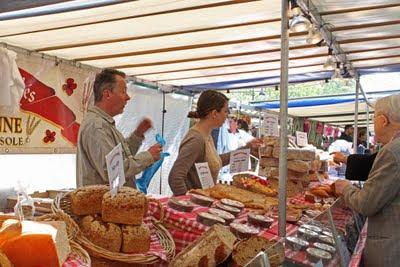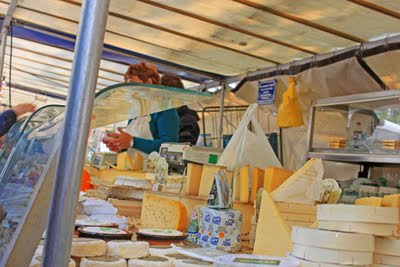After having our espresso and croissant at a local café near our hotel, my daughter and I discussed our plans for the day and knew that our first stop had to be the open-air green market in the 7ème Arrondissement at the lovely Marché Saxe-Breteuil, only a couple of minutes walk away.
There are no fewer than eighty greenmarkets in Paris, the vast majority of them are open-air markets (marchés volants, or roving markets) that operate two or three days a week, most of often in the morning.
But the Marché Saxe-Breteuil has to be one of the most appealing outdoor food markets in Paris. Set in an upscale residential neighborhood, the market is shaded by two rows of sycamore trees and the tall light poles with modern fixtures provide a bit of architectural glamour. The Eiffel tower is in view which adds to the pleasure.
On this particular morning, Paris was awakened by sunshine flooding down through the canopy of trees giving the whole market a golden glow.
As we negotiated our way from stall to stall I was overwhelmed by the mind-numbing assortment of produce
cheese, bread, meat, and seafood
not to mention the household goods. Personal clothing is abundant, flowers, toys, purses, wallets, and other leather goods known as maroquinerie (because they come from Morocco) are displayed as well as oriental carpets, fine lace tablecloths and quilts.
But of course for me, it was the food that captivated my attention, it was a sensory awakening. I felt a kind of camaraderie as I strolled from stall to stall watching the Parisians discussing with the vendors specific nuances of the what seemed like dozens upon dozens of artisanal cheeses displayed, sampling a little of this and a little of that.
I couldn’t believe the abundance of oysters piled high in baskets down a long table. There were plat or flat, and curved/crenellated types. They are numbered 1 through 5 to distinguish the largest (#1) from the smallest #5). A dozen #3’s will set you back as much as a dozen euros in a restaurant, though much less in the open-air market. The vendor seemed to be explaining the fine points of differences among fines de claires, speciales, and belons all from Marennes and Oléron on the Atlantic coast.
There are multiple charcuterie stands with sausages, prosciutto, even pig snouts, which attest to the French genius for finding culinary use for every part of the beast. In an adjacent stall, half a dozen varieties of mushrooms are laid out along with all the glorious greens: crinkly spinach, crisp peppery cresson and my favorite frisée.
Paris is a city over flowing with wonderful ingredients to cook with. If you are truly in love with food, you can be assured you will be in love with Paris. And if you are in love for beauty that runs deep through all genres, Paris will happily take you by the hand and accommodate you.
jouir de,
shannon





















